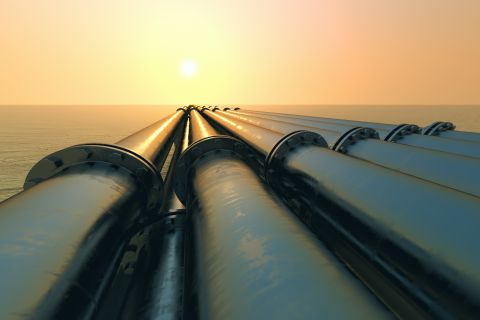Hart Energy: Where is the Midcontinent in demand for water?
Michael Dunkel: I was updating my presentation and one of the things that struck me was when I made a plot of rig counts for Oklahoma over the last 12 months. I plotted against oil prices and I knew oil prices have been more or less flat. What I didn’t know was the rig count is down by two thirds. It has gone from roughly 150 rigs 12 months ago to about 50 in Oklahoma. That is tough. There is a lot of pressure on industry in Oklahoma but also on the sector across the board. I think that there's hope though. In my presentation I talked a bit about the sentiment. The sentiment on Wall Street for the public companies and the private equity companies for the smaller private equity-backed private producers is very negative. Everybody's cautious about investing in this whole thing. But, I think there is hope there. It does allow things to proceed at a more sustainable rate. We are clearly not in a boom. We are off the highs as it relates to water. I think you are going to be sourcing less water. You are going to be disposing of less produced water. It's going to fall off over time potentially but those problems aren't going to go away. I think that water will be very important for Oklahoma. I had a chart about earthquakes. Earthquakes are off their peaks dramatically so I think the projected year-to-date, if you project for a full year there would be about 66 for 2019. The peak year was it 4 years ago there were about 900 and so well that's a good news story but it's water-related but yet then there's a subplot here that there's a few more going in the STACK. More earthquakes in the STACK area which I don't think it'll be a problem. I am optimistic there will be a recovery in the rig count. Oklahoma's production is going to hold up and maybe turn back up hopefully at some point. Then we'll get back to the water management challenges that we have in that up market.
Hart Energy: What is the current regulatory landscape?
Michael Dunkel: In some of my prior roles, one was working with the Oklahoma Water Resources Board on two different studies. One was DOE backed and the other was from the U.S. Bureau of Reclamation. These were public studies, they are on their website. I got a chance to work with the regulators. We worked with the water board but we had a lot from the state of Texas involved. Including Secretary Teague before he left as energy secretary and environment. I have a ton of respect for those folks and that you know the challenge including like the seismicity that we mentioned was the balance. The state does not want to kill off hydraulic fracturing in oil and gas industry. But yet they have an obligation to make sure it's done well and I think that they've done an extraordinary job with that as far as I can see to date they have done a great job. That doesn't mean that it's easy. There were no deaths. I don’t think there were any injuries from seismicity. There was very minimal damage. If things had been worse with one of those, it may have changed how things happened. Apparently there's a water leak in the Kingfisher-Blaine County that is currently being worked and industry is working with the regulators and figuring out the cause and figure out what to do about it. I think that environment is good when there's collaboration. I see a lot of positives in the way it's working in Oklahoma.
Hart Energy: How does infrastructure measure up with the demand for water?
Michael Dunkel: There have been progressive water pipelines built in Oklahoma over the last five years. One of the themes is there's a cycle to a play and in the beginning when operators are jumping around drilling over here and going over there and they're trying to define the core area. It's difficult for them to say let’s go put some water pipe in the ground because we can move water around cheaper because you don't know where you need to put. As the core becomes defined, companies like Continental, Newfield now in Ecana put in water systems to move the water around cheaply. It allows them to optimize and keep a high utilization of their saltwater disposal wells. It is an efficient system in my mind for water. It also allows reuse and I talked about that in my presentation. If you can move water around cheaply, that is the hard part because reuse costs have come down. So I see that happening, but as the rig count falls there's less of a push for that. I think as soon as we turn back up and then perhaps go back to more of a resumption of water infrastructure. Water Midstream is filling that niche. If each oil company tried to build their own water network, they could but it wouldn't be very efficient. If the water Midstream can hopefully aim in the long run to build one system for an area for a corner of a county that'll work for all their operators. In Oklahoma where there's a lot of small operators that model should hope up well.
Hart Energy: What role does technology play in the water space?
Michael Dunkel: A couple of things come to mind here for water and technology. The first one really is Automation. We have had talk about big data and all, but you don't want to have to have a person go drive out to see if your water impoundment is full or not yet. In the beginning of the Shale plays that's what they did and now we have the technology to know how full is it how many barrels are in that impoundment and then it evolves. As you begin to link together your system, hopefully where people are headed is automated so that I can turn on and off, open and close valves and pumps, move the water to where I need to do it without a major labor-intensive a footprint. Also part of that automation of pipes is a leak detection system. If you're going to be moving around big volumes of produced water, you want to know if you have a leak. So this automation will help you see that and take action quickly if it occurs. The other part I think of technology that comes to mind is water treatment. There has been an evolution toward water fracs, away from the hybrid fracs, gel fracs that typically needed a higher quality water. What's happened is industry has been able to figure out, if we can use lower quality water but we need to treat it some, and I think the technology has come around to do that minimal treatment but do it very cheaply. Sometimes just treating it in the impoundment itself. That has helped reuse. Reuse is up in Oklahoma, reuse is up in Permian. That water treatment cost has been a benefit to the folks trying to do that.
Hart Energy: Do you see the work being done in that area of reuse and treatment as a chance for industry to address being more environmentally conscious?
Michael Dunkel: I absolutely believe there is a lot of pressure on industry from environmental, social and governance. Water is part of that. I think actually climate change which is mostly about air emissions is a bigger part but how industry deals with water today is secondary. I would say if you go back to 2011 and 2012 when Oklahoma and Texas had bad droughts that water was a really big issue and it has subsided because we've gotten a lot of rain. I think that how we do water how we can handle it. No spills or limited spills, clean them up and then can we reuse water more often, can we minimize the amount of freshwater that we use. One of the things as part of the groundwater protection council study, I went and looked at all of the websites of the top 10 producers in America. All 10 of them, and I was surprised by this, all 10 of them have an objective on their website. “We want to minimize fresh water use.” I think what was encouraging was, yes they have this corporate thing, but I know all those water managers and they're trying to make that happen. So there's really two ways you can either use brackish water or you can reuse produced water. Companies are doing both of those increasingly over the last few years or so. I think it's important they're trying but they still have their budget and cost issues, they have to have one eye on each of those as well.
Recommended Reading
US Natgas Prices Hit 5-week High on Rising Feedgas to Freeport LNG, Output Drop
2024-04-10 - U.S. natural gas futures climbed to a five-week high on April 10 on an increase in feedgas to the Freeport LNG export plant and a drop in output as pipeline maintenance trapped gas in Texas.
Midstream Builds in a Bearish Market
2024-03-11 - Midstream companies are sticking to long term plans for an expanded customer base, despite low gas prices, high storage levels and an uncertain political LNG future.
Turning Down the Volumes: EQT Latest E&P to Retreat from Painful NatGas Prices
2024-03-05 - Despite moves by EQT, Chesapeake and other gassy E&Ps, natural gas prices will likely remain in a funk for at least the next quarter, analysts said.
Mexico Pacific FID Imminent for Saguaro LNG Trains 1 and 2
2024-04-04 - Mexico Pacific Ltd. is close to taking an initial final investment decision for the first two trains at its Saguaro Energía LNG facility in Sonora, Mexico, which will source feed gas from the Permian Basin.
Enterprise Increasing Permian NatGas Production
2024-04-03 - Enterprise Products Partners began service on two natural gas plants: the Leonidas in the Midland Basin and the Mentone 3 in the Delaware Basin, each with a capacity to process 300 MMcf/d of natural gas and 40,000 bbl/d of NGLs.




